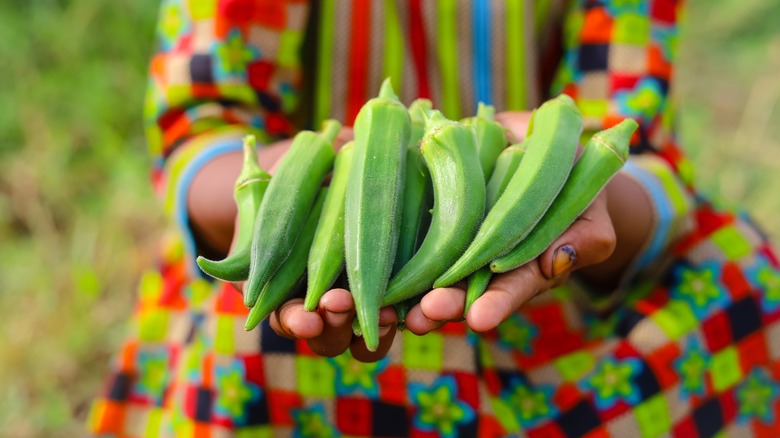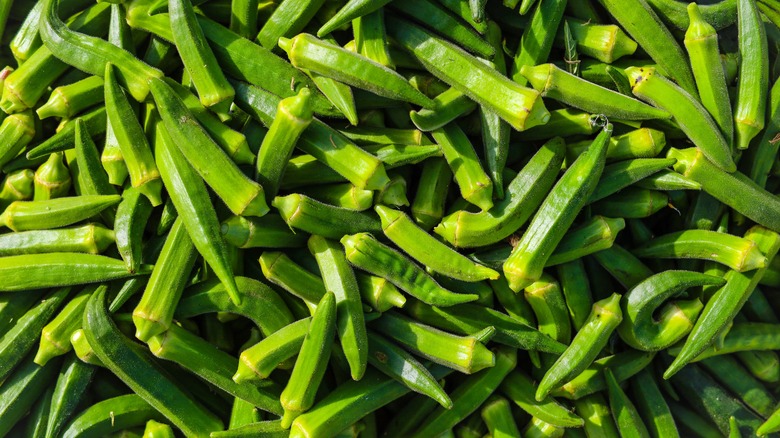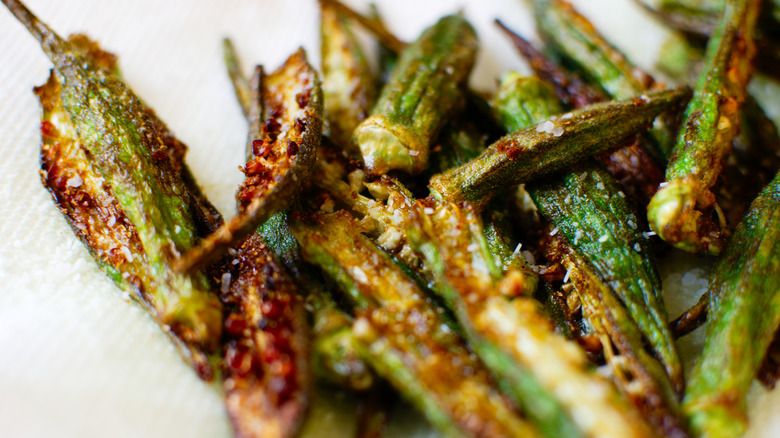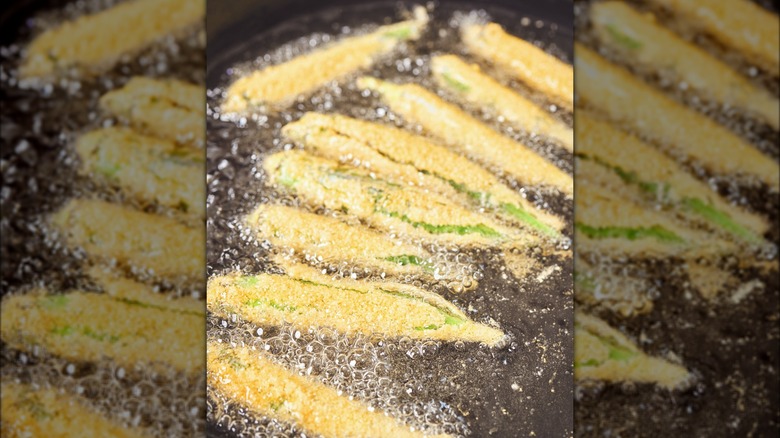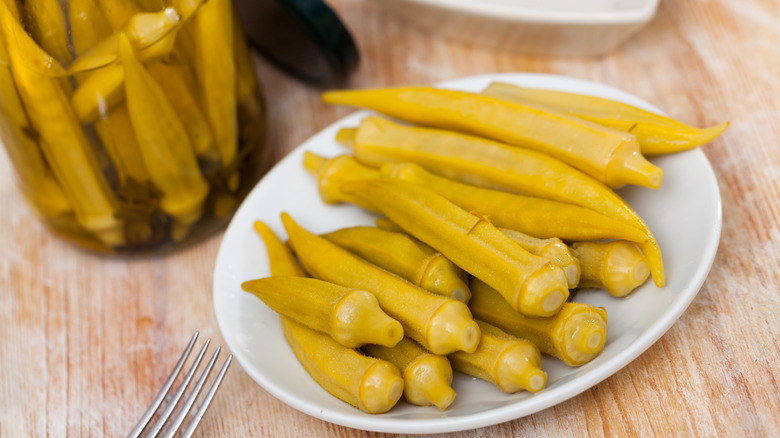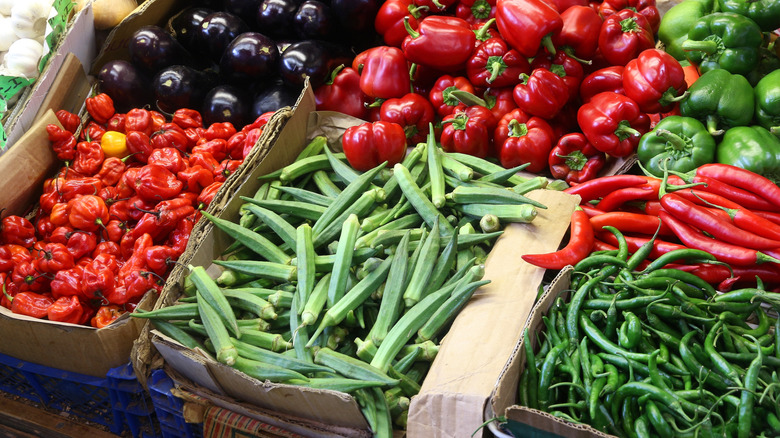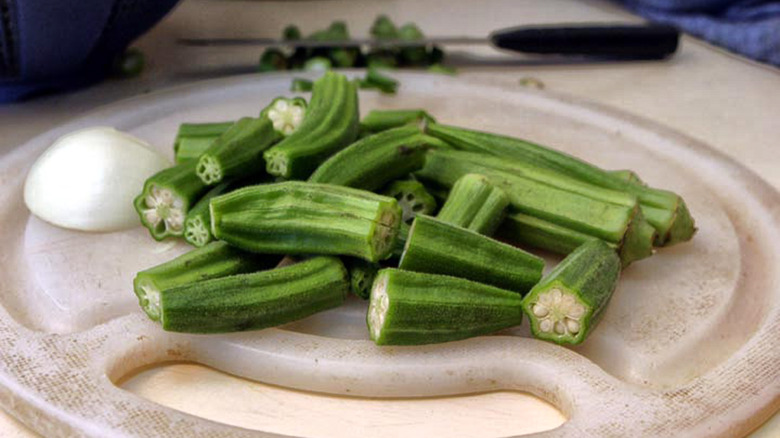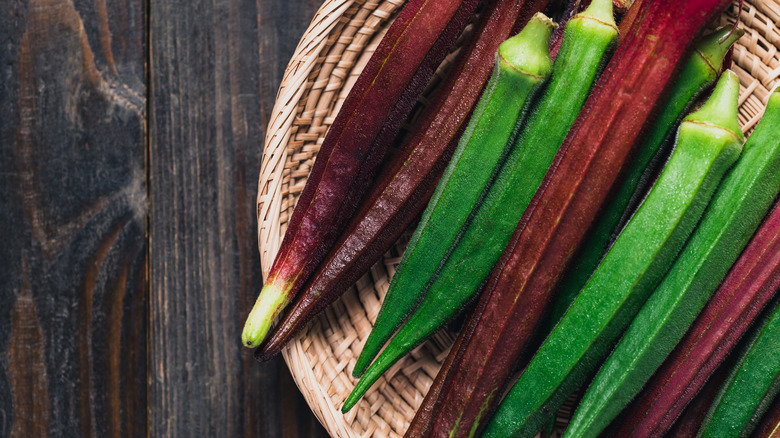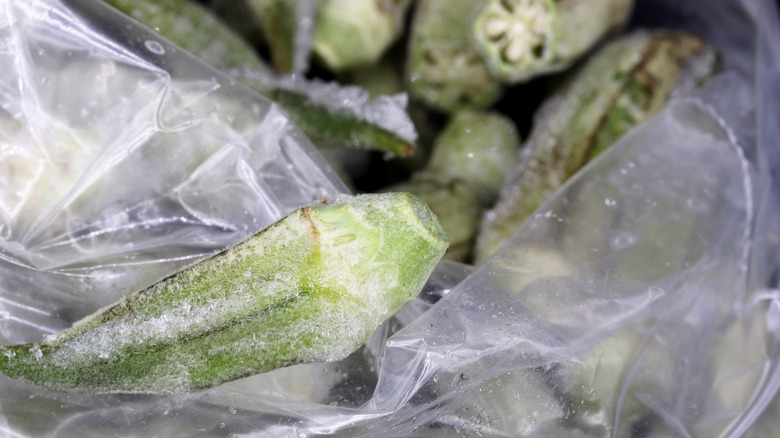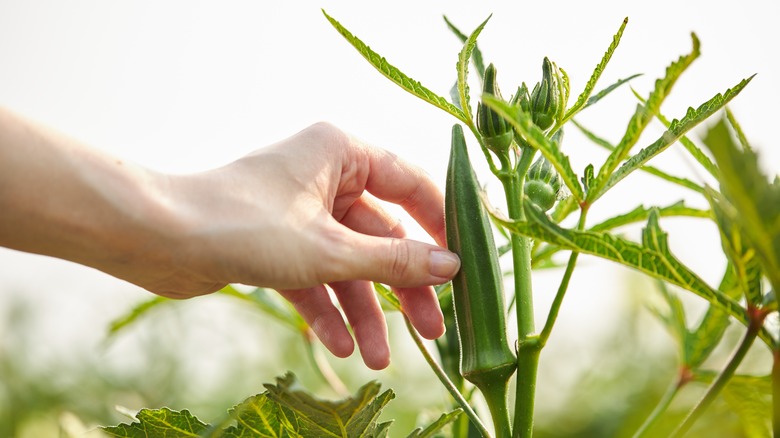What Is Okra And How Do You Cook It?
Okra is a staple vegetable in southern states of the U.S., but many Americans in other parts of the country don't know much about this plant and its edible seed pods. Okra comes in a number of varieties, but the one most common in the US takes the form of green tubular pods filled with seeds. If you live on one of the coasts or in the Midwest, chances are you've never tried this scrumptious fruit. You might be familiar with its reputation for being bitter and having a slimy texture. That can sound off-putting, for sure, and certainly is the case sometimes, but by and large, this is the result of poor cooking. When prepared correctly, okra can be an excellent side dish or a tasty component of a larger meal.
There are many ways to cook okra. You can bake it, fry it, stick it in a stew, or prepare it dozens of other ways. Like any fruit, legume, or vegetable, the sky's the limit in terms of how you can prepare and cook okra. But what exactly is okra, scientifically, and where does it come from? We've put together a crash course on the essentials of this fascinating plant and its edible fruit.
What is okra?
Okra is a plant that also goes by the scientific name Abelmoschus esculentus (aka Hibiscus esculentus) and belongs to the Malvaceae, or mallow family of plants. It's also been commonly referred to as "gumbo" and "lady's fingers" over the years. The plant is originally native to Africa but is grown in subtropical regions around the world, particularly in Asia, Southern Europe, and the Americas. The parts of the okra plant we eat, usually called pods or capsules, roughly 4-12 inches long, with a diameter of up to an inch.
If you're paying attention, you may have noticed we've referred to okra as a fruit. If you are a discerning foodie or botanist, you may have picked up on the fact that okra is often called a vegetable, but as we described, the edible pod has seeds. This technically makes okra a seed pod or fruit. Like tomatoes or avocados, this is a fruit that is commonly misidentified as a vegetable due to its look, taste, and culinary uses.
Where does okra come from?
Okra isn't just a staple in Southern cooking; it's an essential part of Black American food culture in the United States. To this day, okra remains very popular in West African cuisine as well as in Creole cuisine. It most likely came here by way of Africa in the early 1700s.
Just like gumbo and other Creole ingredients and recipes, it's suspected that okra was brought to America by enslaved peoples. Charlotte Lyons, former Ebony Magazine food editor, told Life and Thyme, "I know that a lot of the slaves, when they were forced onto the Middle Passage, they would put okra seeds in their hair or hide it somewhere. They were the ones that brought the seeds to America."
In the same interview, James Beard award-winning food historian Michael W. Twitty pinpointed okra's arrival in the US somewhere between 1710 and 1730. By the end of the 18th century, the ingredient was synonymous with Southern Creole cooking. It has remained a staple of the cuisine for the past 250 years.
What does okra taste like?
The okra enjoyed in the U.S. tends to have a grassy, earthy flavor, and it often gets compared to eggplant or fresh green beans. Naturally, the flavor changes as you cook it, as does the texture, which is another important part of the okra eating experience.
Okra has a reputation for being very slimy. If you try to eat the pods raw or if the okra is improperly cooked you will taste that slippery, mucilaginous texture and consistency. Raw pods tend to be crunchy on the outside and gooey on the inside. Food safety consultant Millie Ngaru told Southern Living that okra mucilage "is made up of sugar residues called exopolysaccharides and proteins called glycoproteins, which increase once the heat is applied." When cooking with okra, you can either take steps to eliminate this sliminess or you can embrace it. With that being said, different varieties of okra will have different tastes and textures, like Chinese okra, which is more similar to zucchini.
How to cook okra
There isn't just one way to cook okra, and any preparation can make it delicious if you know what you're doing. Feasting at Home's Sylvia Fountaine told Southern Living that "the more okra cooks, the slimier it gets, because the sugars that create the slime are released." This means the best methods to eliminate the slime factor from okra are to flash fry the okra or cook it in another quick manner.
Fried okra is an extremely common preparation and one of the easier and quicker ways to cook it. By dredging chopped-up bits of okra pods in cornmeal or a light breading of your choice, you'll give it a crunchy, salty exterior. When you cook okra quickly, like in deep-frying, it crisps up on the outside and prevents the mucilage from overdeveloping. Alternatively, you can take advantage of the mucilage by adding okra to a soup, stew, or gumbo. Due to its properties, okra acts as a natural thickener in these types of hearty dishes, which ends up being more flavorful than using cornstarch or flour.
Regardless of how you cook it, though, don't forget to thoroughly rinse and dry your okra before working with it. There are right and wrong ways to wash your produce, so make sure you're prepping properly so your food is safe to eat.
Other okra preparations
If you don't want to cook your okra, there are a couple of other ways to turn the fruit into a delicious snack or side dish. Pickled okra, for example, is pretty popular. You can find it sold in jars at some stores, but it's also quite easy to make yourself.
Even people who have claimed to hate okra, have found they have a soft spot for the pickled variety. Using a similar dill and vinegar-forward solution that you would use to pickle a cucumber will yield a crunchy, sour result that pops with flavor. If the texture of cooked okra turns you off, the pickled variety gives you something completely different to chew on.
Dehydrating okra is another preparation that can turn it into a healthy snack. The most practical way to do this is with a food dehydrator, which is an essential kitchen tool. Chop your okra up into thick slices and pop them into that bad boy for a few hours, and you'll have a healthy, crunchy snack (with no slime whatsoever) in no time. All you need is a little salt to sprinkle on them, and you'll be hooked on okra all over again.
Where To Buy Okra
Okra is a regional and seasonal ingredient. This means, unfortunately, you won't find fresh okra at every grocery store in America in the same way you can find broccoli, for example. Whether or not okra will be available at a store is also dependent on the time of year. Since it grows best in warm weather, it is not in season during the winter months, making it much harder to find fresh at that time of year. If you're looking for okra, we recommend the produce aisle of organic markets or stores like Whole Foods in the summer or autumn months.
When you're looking for good quality okra at the grocery store, look for the brightest green pods possible. Color and structural integrity are two important indicators that an okra pod is still fresh and has not yet gone bad. If you can't find fresh okra but are still inspired to cook with it, check the freezer aisle. Frozen, cut okra is easier to find, and is sold at retailers like Target. You can also try out the canned goods aisle for pickled or canned okra. These aren't available everywhere either, but Walmart sells jarred pickled okra in some states.
Nutritional Information About Okra
We've established that it takes some work to make okra delicious, but fortunately, every form of the fruit is nutritious. With over 3 grams of fiber per 100-gram serving and a quarter of your daily recommended value of vitamin C and vitamin K, okra is beyond nutrient-dense; it's bordering on being a superfood. It is also rich in antioxidants and, according to a study published in the journal Nutrients, can be an anti-fatigue agent.
Basically, eating an okra-rich diet will probably make you feel better and more energized. It can also reduce your risk of long-term health issues. High levels of fiber have been linked to a reduced risk of colorectal cancer, according to the Journal of the National Cancer Institute. And a study in the journal Plants notes that okra is a traditional medicine for "treatment of worms, dysentery, inflammation, and also irritation of the stomach, intestines, and kidneys." These studies only scratch the surface of the health benefits okra can provide.
Varieties of Okra
There are over a dozen varieties of okra that grow across the world. They come in a variety of colors and sizes, but the majority are some shade of either green or red. Gardening experts and seed sellers Eden Brothers offers 13 different varieties of okra seeds on its website. These include popular green varieties like Emerald Okra and Clemson Spineless, but range to colorful options like Red Burgundy and Jing Orange. Some types of okra are extra long, like the Cow Horn which can grow up to 14 inches in length. Others, like Star of David okra, are shorter but wider. When you cut the pods of this strain open, you get a star-shaped piece, hence the name.
Different varieties of okra grow in different parts of the country, and the types grown vary from state to state. Other okras that grow in Texas include Annie Oakley, Blondy Burgundy, Cajun Delight, Louisiana Green, Stewart's Zeebest, and Velvet.
How to store okra
One of the biggest downsides of buying fresh okra is that it goes bad pretty quickly. Okra should be stored in the refrigerator, but even there it will only stay fresh for two to three days. If you have okra you don't need to use for a week or more, you might want to consider an alternative, and freeze it. If you take the extra steps to blanch your okra, you can store it in the freezer for months until you need to cook with it.
Since fresh okra can be rare to find out of season, cooks who grow their own tend to freeze their harvest so it can last through the year. The first step is blanching, aka cooking for a short time in boiling water before transferring to ice water. According to Food Network, blanching okra before you freeze it "deactivates enzymes that can affect its color and texture." You can skip this step, but there is a chance that your okra will become extra slimy when thawed and cooked if you do.
Following the blanching, you need to decide whether or not to cut your okra pods into slices. If you tend to roast or fry okra whole, there's no need to cut it before freezing. But if you plan on using okra slices, it's best to do this step now rather than later, when the pods are frozen.
How to grow okra
The final step for any okra fanatic is growing your own. Luckily, this is possible in any part of the world with either tropical, subtropical, or warm temperate climates. Many varieties of okra can be grown in several parts of the world. This makes most of North America perfectly fine, although if you live in a state with longer, colder winters, your okra pods will likely not grow to the same size as they would if you were living in, say, a southern state like Georgia or Texas. In colder regions, your okra can benefit from being kept in a greenhouse. Based on the climate alone, your chances of being able to grow fresh okra in your own DIY garden are pretty high.
The best time to plant okra is either in the spring or the early fall. According to Texas A&M, spring okra should be planted at least two weeks after the winter's last frost and fall crops at least three months before the first fall frost, near the end of the summer. Okra plants take about two months to start to flower and produce pods, and will then continue to bloom for the next 10 to 12 weeks. Since okra is a hot-weather plant, it's fairly drought tolerant and doesn't require much watering. A Penn State gardening expert says that about one inch of water per week, either via rain or self-watering, should be sufficient.
